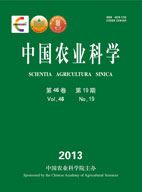-
Variation Laws of Carotenoids Content in Storage Root of Orange-Fleshed Sweetpotato and Its Relationships with Major Economic Traits
- HOU Meng, ZHANG Yun-Gang, WANG Xin, TANG Wei, LIU Ya-Ju, TANG Zhong-Hou, JIN Rong, YAN Hui, MA Dai-Fu, LI Qiang
-
Scientia Agricultura Sinica. 2013, 46(19):
3988-3996.
doi:10.3864/j.issn.0578-1752.2013.19.004
-
 Abstract
(
612 )
Abstract
(
612 )
 PDF (604KB)
(
995
)
PDF (604KB)
(
995
)
 Save
Save
-
References |
Related Articles |
Metrics
【Objective】Accumulation laws of carotenoids content in storage root during development and among varieties and their relationships with major economic traits in orange-fleshed sweetpotato (Ipomoea Batatas (L.) Lam) were studied in present paper.【Method】The dynamics of main economic traits in 15 orange-fleshed sweetpotato varieties on 50, 64, 78, 92, 106, 120, and 134 d after transplanting were investigated, and these traits included the carotenoids content, longest vine length, branches number of vine system, storage roots number, dry matter contents in stem, foliage, petiole and storage roots, fresh and dry weights of storage roots, fresh and dry weights of stem, fresh and dry weights of foliage, fresh and dry weights of aboveground plant, fresh and dry weights of whole plant, and ratios of photosynthate to storage roots, stem, foliage and petiole. The relationship between variations of the carotenoids content and other economic traits during whole developing stage was analyzed. And the relationship between daily growth rates of the carotenoids accumulation and other main economic traits was also analyzed. 【Result】During the whole development, the carotenoids content had three variation types, that is totally leveling, straightly increasing and deviously ascending, and had different responses to the growth of longest vine length, fresh and dry weights of storage roots, photosynthate distributions, and so on. For most of the tested varieties, especially the straightly increasing type in the study, the carotenoids contents had a significant positive correlation with longest vine length, fresh and dry weights of storage roots and ratio of photosynthate to storage roots, and had a significant negative correlation with the ratio of photosynthate to foliage and petiole, however had a least correlation with other traits. Because of the positive correlation between daily growth rates of carotenoids accumulation and fresh and dry weights of storage roots, starch accumulation, soluble sugar accumulation, crude protein accumulation, the carotenoids and dry matter, main nutrient substances accumulated synergistically in storage roots. 【Conclusion】The significant difference and differentiation of carotenoids contents among varieties would take place during development of orange-fleshed sweetpotato, and there were totally leveling, straightly increasing and deviously ascending variation types of carotenoids content because of the synergistical accumulations between carotenoids and dry matter in storage roots among varieties. These variations of carotenoids accumulation had different relationships with main economic traits during development and among varieties in orange-fleshed sweetpotato.









